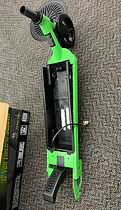Boost

is a wheelchair add-on that provides motorized assist to caregivers pushing individuals with cognitive disabilities.





Intuitive interface for changing power setting without compromising grip
All components clip or screw onto a manual wheelchair for easy, intuitive installation
Moving parts are covered to ensure safety.
Lightweight, detachable battery for easy charging
How does the caregiver activate the motors?

Inner piece is fixed snugly to the handle
Outer piece is free to slide

When pushed, the outer piece presses a button that signals the motors to run
What does this mean?
It's lightweight
The whole system only adds about 14lbs, so the wheelchair can still be lifted when necessary.
It's retrofittable
Everything snaps and screws onto a manual wheelchair. No need to buy a new one.
It's intuitive to use
Just push to engage the motor. It stops when you stop.
Power is adjustable
Whether you need a small boost over a doorway or are pushing up a steep hill, there's a setting for you.
The Process
This section will show how I used the design process and my engineering background to design the user interface and make a works-like model.
By applying what I learned in class, I was able to develop new skills in a hands-on way.
Design research: problem space exploration and data synthesis
Started with interviews
I talked to a lot of people in the disabled community, such as:

Physical/occupational/music therapists
Full-time caregivers and wheelchair users

And even a medical product engineer

I found that...
Full-time caregivers of people with cognitive disabilities need something to help them push wheelchairs up hills and over rough terrain.
Long-term pushing of wheelchairs can lead to pain and injury in the wrists, back, hips, and knees.
Isn't that what powered wheelchairs are for?
Powered wheelchairs are great! They allow independence and increased mobility. However, they are:
Heavy

Caregivers need to load wheelchairs in and out of cars or on public transportation
Expensive

Insurance only covers 1 powered wheelchair every 10 years but...
1 manual wheelchair every 5 years

Dangerous

People with cognitive disabilities don't have the fine motor skills or reaction time to operate a joystick
Neither manual nor powered wheelchairs work for people with cognitive disabilities...

There needs to be something in the middle of being fully motor powered and fully human powered
"I don't mind pushing. I just sometimes want a little extra help like a little BOOST."
- Kaitlyn, caregiver for dad
All of my research led me to this idea of a boost which provides both a literal and figurative assist.
I drew inspiration from e-bikes that aren't fully motorized or user powered, but the
motor helps the user as needed.
This led to my central HMW...
How might we design a wheelchair add-on that makes it work with an assist like an e-bike?
User interface designing: ideating, prototyping, and validation research
It wouldn't be design work without brainstorming on sticky notes


Which were then made into low-fi prototypes for user testing
I found that users wanted...

A secure grip
Hands and feet should not need to move to activate

No digital
Concerned about lag

Movement mimicking
The wheelchair should only move when pushed by the caregiver
Caregivers need to feel in control
This is how I came to create the user interface that:
1.) Only moves when the caregiver is pushing and depresses the button
2.) Doesn't require any new behavior or grip change from the caregiver


Works-like prototype engineering: physics and mechanics
First, I calculated the total power and torque I would need from the motors
Power = 230 W
Torque = 60 Nm





Then I gutted a scooter so I could use the parts for the prototype
I learned a lot about electronics
(and started some fires...)







I used OnShape and 3D printers to make tons of prototypes
Then I assembled everything to make a working prototype

Takeaways: learning and skills
What I learned:
-
Don't fall in love with a solution before conducting research.
-
I thought I was going to build a modified powered wheelchair when I started. I completely changed direction after analyzing my research.
-
-
Trial and error are the building blocks of design.
-
I had to make so many prototypes and wanted to give up, but I kept going and eventually created ones that worked.
-
-
Ask for help or you won't learn.
-
I was an engineer in undergrad, but I found that I knew little about mechanics. I had to swallow my pride and rely on my classmates for help, but I understand much better than if I tried to figure it out on my own.
-
Skills I developed/refined:
-
Electronics
-
RasPi, Circuit Python, Mu Editor
-
-
CAD and 3D printing
-
OnShape, Bambu Carbon X1, Prusa MK3 and MK4
-
-
Fabrication
-
Lathe, band saw, hand tools, fasteners
-
-
Presenting research and ideas
-
Public speaking in front of subject matter experts and laymen
-